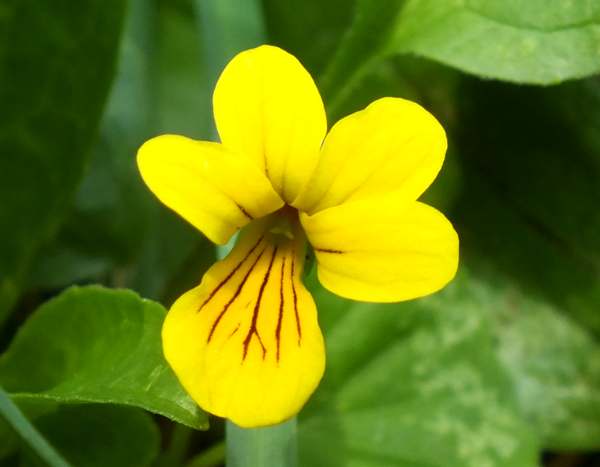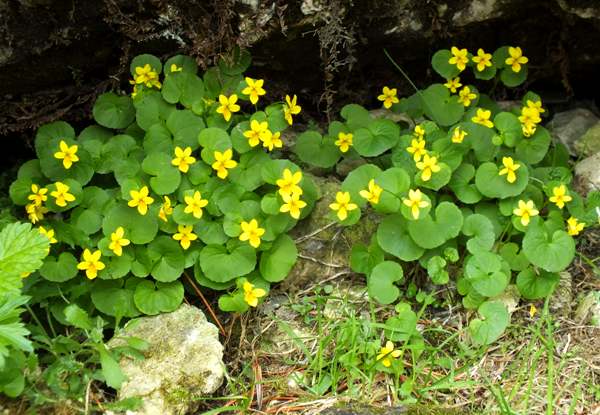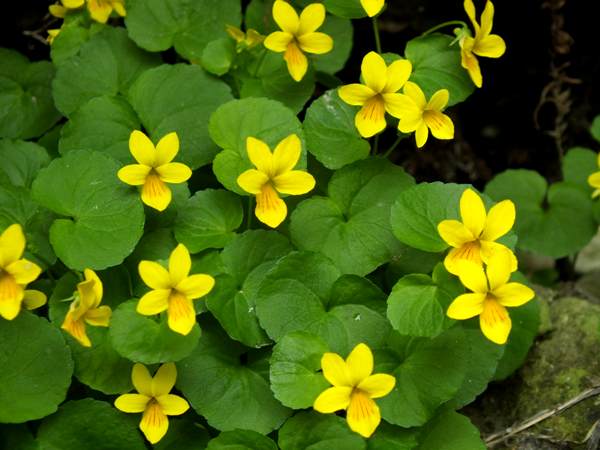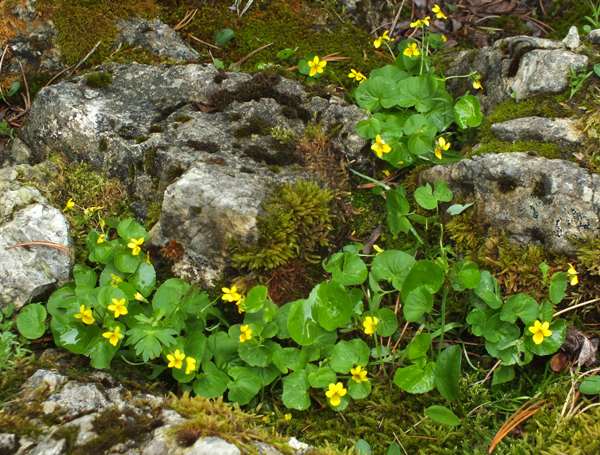Trees Birds Mammals Fish Amphibians Reptiles
Wild Algarve
Bookshop
Viola biflora - Two-flowered Violet
Phylum: Magnoliophyta - Class: Equisetopsida - Order: Malpighiales - Family: Violaceae

This gregarious member of the pansy family has many common names including Yellow Wood-violet, Arctic Wood -violet, Twinflower Violet and Alpine Yellow-violet.

Description
Plants are perennial and grow to about 20cm in height often in neat pincushion shapes. The fragrant, red-veined yellow flowers are typically 1cm across and have five petals the lowest of which has a short spur; there are five small sepals and each flower has five stamens fused in a single style. Its basal leaves are roundish and there are kidney-shaped stalked leaves opposite on the stem. As with other members of its genus, Viola biflora produces three-valved seed capsules.

The flowers and kidney-shaped leaves of Viola biflora seem to shine even in dark crevices.
Distribution
Viola biflora is not native to Britain and Ireland (although it has long been a popular garden flower), but it occurs in alpine locations throughout most of mainland Europe and in many parts of Asia including India and China; it is also recorded in North America.
Habitat
This is an alpine wildflower and occurs at altitudes of up to 3500m above sea level. Sheltered and shaded damp places are the preferred habitat of the Two-flowered Violet. We have seen then growing profusely beside wooded mountain streams and crouched beneath rock outcrops on north-facing slopes, always where they are not exposed to bright sunlight or strong winds. In Scandinavia this violet is also common in broad-leaved woodlands and crouched beneath other vegetation in tundra.
Flowering times
The flowers appear in May and June at lower altitudes but may be seen well in to July in colder high-altitude locations.

Etymology
Most members of the family violaceae have flowers with some purplish areas or at least flowers some of which have purple or violet in their colouring. The genus name Viola reflects this feature; however, Viola biflora is an exception in that it has consistently yellow flowers.
The specific epithet biflora means 'with two flowers'. You might therefore expect that the flowers are borne in pairs, but they are not. Rather, the name refers to the fact that this species produces two kinds of flowers: as well as the lovely and conspicuous yellow flowers it also produces, low down under the leaves, pairs of very basic flowers that do not open but self fertilise within their buds - a process known as cleistogamy.
The photographs shown on this page were taken in the Dolomite Mountains, northern Italy, in May.
Sue Parker's latest ebook is a revised and enlarged second edition of the acclaimed Wildflowers in the Algarve - an introductory guide. Full details here...
Buy it for just £3.95 on Amazon...
Sue Parker's 5-star acclaimed field guide to the Wild Orchids of the Algarve is now available as an ebook. Full details here...
Buy it for just £5.95 on Amazon...
Please Help Us: If you have found this information interesting and useful, please consider helping to keep First Nature online by making a small donation towards the web hosting and internet costs.
Any donations over and above the essential running costs will help support the conservation work of Plantlife, the Rivers Trust and charitable botanic gardens - as do author royalties and publisher proceeds from books by Pat and Sue.